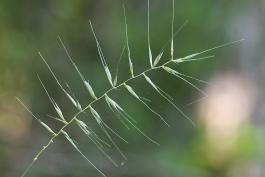
Bottlebrush grass is a native perennial, tuft-forming wild rye lacking rhizomes; the roots are fibrous. It grows statewide, typically in woodlands. The widely spaced spikelets spread away at a right angle from the main flowering stem.
The leaf blades are narrow, 4–12 inches long, flat, upright, roughened and usually hairy on the upper surface, usually with two small earlike structures where the leaf blade joins the stem.
The bristly flower heads are 2–6 inches long, upright or slightly arched, appearing flattened, with usually 2 spikelets per node. Each spikelet holds 2–4 florets; at maturity, the spikelets spread away from the main stem at a right angle. Each floret has 2 prominent, hairlike awns extending straight outward; these awns can be ½–1½ inch long. Botany nerds will find it interesting that the spikelets usually lack glumes (glumes are the pair of largish, protective bracts at the base of each spikelet, and most grass spikelets have them). Flowers June–August.
Similar species: Some 12 species in genus Elymus — as a group, called wild ryes — have been recorded for Missouri. Wild ryes are in a subdivision (tribe) of the grass family along with many familiar and similar-looking genera, including goat grass, crested wheatgrass, barley, rye, and wheat. While most people use the form, size, and shape of roots, stalks, leaves, flowers, and fruits to distinguish among plants, botanists today are using molecular (DNA) characteristics to carefully organize this tribe of grasses.
Fortunately in this group, bottlebrush grass is distinctive for the appearance of its flower clusters: the widely spaced spikelets that spread at a right angle away from the main flowering stem are a key character. But note that bottlebrush grass may sometimes hybridize with other grasses in its genus, and the offspring may have characteristics intermediate between the two parent plants. Virginia wild rye (E. virginicus) is one of the species with which it can form hybrids; the offspring are called Ebinger’s wild rye (Elymus x ebingeri).
Height: flowering stems 20–60 inches.
Scattered to common nearly statewide.
Habitat and Conservation
Occurs in bottomland forests and mesic (moist) to dry upland forests, less commonly margins of glades and upland prairies, ledges of dolomite bluffs, and banks of streams. Also occurs in pastures and disturbed areas.
Status
Native perennial tuft-forming, cool-season midgrass without rhizomes.
Human Connections
Bottlebrush grass can be used as a drought-tolerant, clump-forming ornamental grass good for naturalized settings in light shade. The unusual flowering heads are interesting additions to flower arrangements.
The species name, hystrix, is the genus name for Old World porcupines; it is basically the same as the ancient Greek word for “porcupine.” It refers to the spiny look of the flower clusters. Interestingly, our New World porcupines are in a different family than those on the other side of the world.
As a food for livestock, bottlebrush grass is good when young and tender, but as the flower heads mature, the long, spiny awns can injure grazing animals.
Much of science is about solving puzzles. Because bottlebrush grass lacks glumes (see Description above), it was once placed in its own genus and called Hystrix patula. But because it easily interbreeds with Virginia wild rye (E. virginicus), the two plants seemed clearly to belong in the same genus. The naturally occurring hybrids were a clue to their close genetic relationship, even before DNA studies were possible.
Ecosystem Connections
The northern pearly-eye butterfly uses bottlebrush grass, river oats, and other grasses of deciduous woodlands as its caterpillar host plants. To escape predators, these woodland butterflies often skip quickly into a clump of grasses, where they seem to disappear.
A variety of other insects feed on this grass, including grasshoppers, aphids, leaf miners, stem miners, leafhoppers, moth larvae, and more.
Seed-eating rodents and birds, such as mice and sparrows, eat the seeds. Grazing animals eat the foliage and young flower heads.
Like other low groundcover plants of woodlands, bottlebrush grass in important for stabilizing soils, preventing erosion. Land managers use bottlebrush grass when they are restoring woodlands and savannas.
































